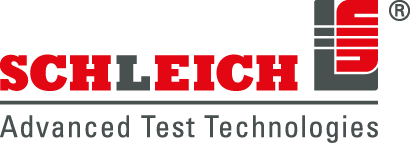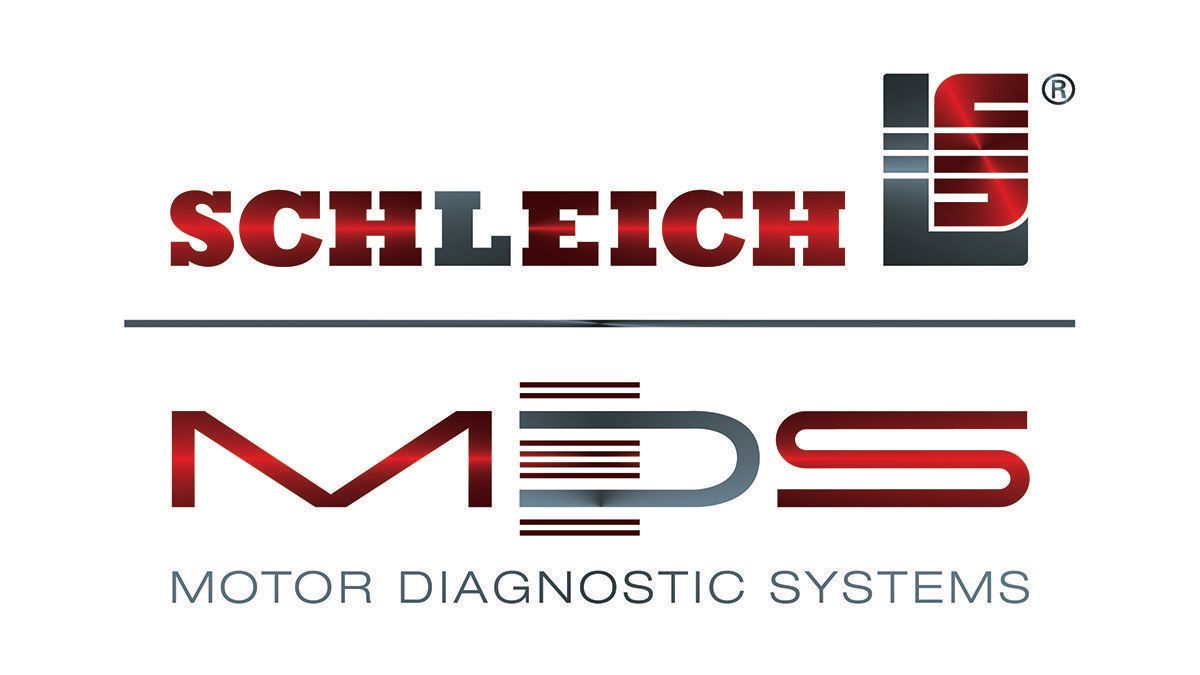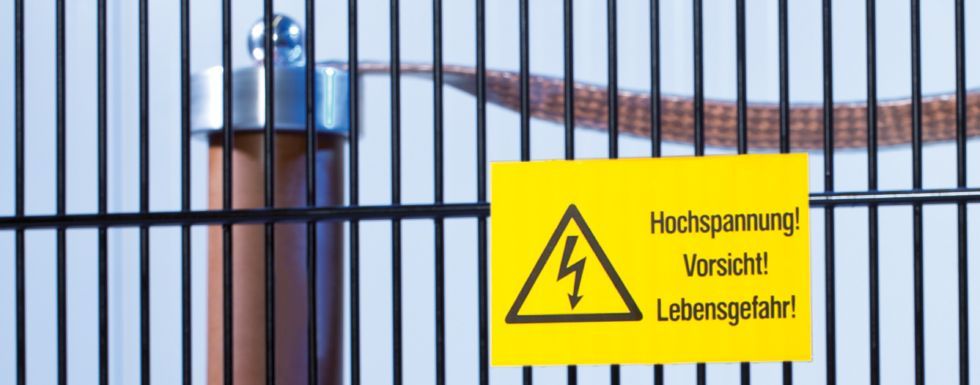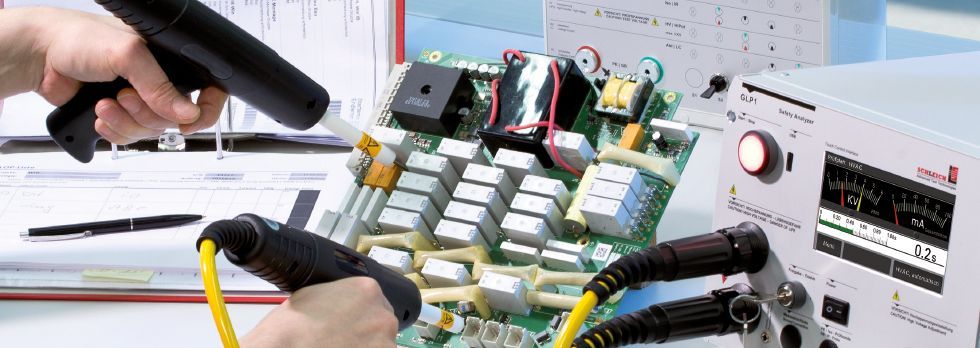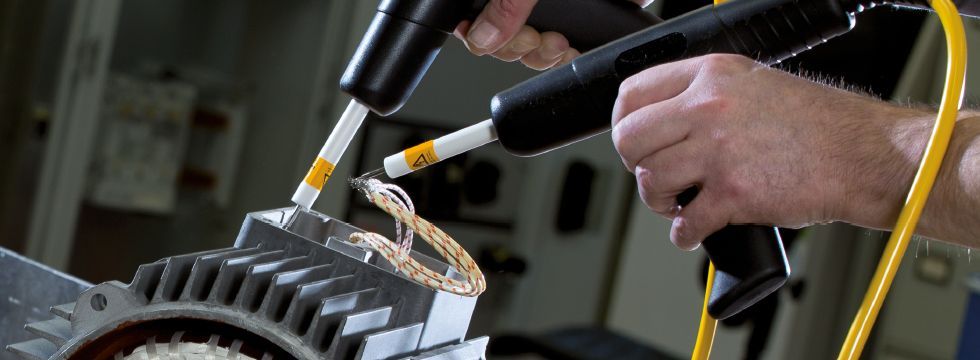Schleich Test Technologies
Insulation Testers
Everything you always wanted to know about insulation testing.
The insulation test (also called “IR” test worldwide) determines the insulation resistance in measuring ranges from kΩ to TΩ. Many test regulations (e.g. VDE, EN, IEC, UL ...) require the measurement and assessment of the insulation resistance.
Why is the isolation test so important?
Washing machine, electric motor, lamp ... these and almost all other electrical products and electrical systems can only be operated safely if they have high electrical insulation strength.
In the worst-case scenario, poor insulation can lead to electrical accidents resulting in serious injury or death, or to significant product damage.
With the insulation test you determine the insulation quality of your test object. Electrical products are checked with test voltages typically between 500 and 1,000 VDC.
In order to cover almost all areas of insulation testing, SCHLEICH supplies insulation testers from 25 V up to 50,000 VDC based on a very extensive range.
Where is the test object tested?
The test is between all current-carrying conductors and from current-carrying conductors to the housing.
In principle, the insulation test takes place between the same test terminals as the high-voltage test.
What errors does the insulation test reveal?
- Insulation weaknesses between any electrical conductors to the protective conductor / device housing
- Poor insulation between the electrical conductors
- Poor insulation at air and creepage distances
What are the good/bad criteria?
The assessment of the insulation test is always based on the ohmic insulation resistance, which is measured between the two poles of the test voltage. It must not fall below an adjustable limit.
Insulation test always with DC.
The insulation test always takes place with a DC test voltage.
Why?
Test objects often have unavoidable capacitances due to filter capacitors or their physical construction. Testing with AC would have the disadvantage that a high capacitive leakage current would flow through these capacitances. The real resistance could not be determined precisely enough under such conditions.
If, on the other hand, testing is carried out with DC, the capacitance only plays a subordinate role. After the capacitance has been charged, only a very small insulation current flows through the insulation resistance.
On the basis of the voltage applied and the current flowing, the insulation resistance is calculated using Ohm's law.
How is the insulation test carried out?
Whether manual, partially or fully automatic: with insulation testers from SCHLEICH, every test task can be carried out quickly and efficiently.
Our testing devices are all designed according to the "KISS principle". So according to the motto: " Keep It Simple and Smart " . The principle is the leitmotif for all SCHLEICH products.
Partially or fully automated insulation test devices or automatic insulation testers are more suitable for the requirements of production companies. For this purpose, the test devices are equipped with a relay switch panel (relay matrix). These automatically switch the test voltage to the desired test points. A manual test is carried out with a test probe. To do this, the operator guides the test probe by hand from test point to test point. Despite the manual process, the test can be perfectly documented. A typical application here is the testing of electrical products, control cabinets and machines according to the Machinery Directive EN60204.
Depending on the application, test systems of this type have up to 1,000 test connections.
Safe implementation of the insulation test.
Working with high test voltages is not without risk. Appropriate safety regulations must therefore be observed.
With SCHLEICH insulation testers, the test current is always limited. The integrated safety current limiter limits the test current to a maximum of 3 to 12 mA DC. This limitation allows the insulation testers to be operated without test hoods.
However, a second criterion must also be taken into account:
Many test objects have an unavoidable capacitance due to their construction. This capacitance is charged during the test and stores the charge. The maximum stored energy must not exceed 125 mJ (Q = 1/2 x C x U 2 ). Otherwise, even after the test, the operator could get a dangerous electric shock when touching the test object due to the residual charge/residual voltage.
If the test device is still connected to the test object after the test has been completed, the test device internally ensures safe discharge.
However, if this cannot be reliably guaranteed, test hoods, test cabins, light curtains or barrier chains are used as protective measures.
Potential-free insulation test?
The potential-free insulation test is used in most applications. It is typical for the use of test probes up to 1,000 V DC or with safety test guns up to 10,000 V DC. It guarantees the highest level of safety for the user.
At higher high voltages from 15,000 V upwards, the test voltage is usually earthed on one side.
What else do you need to consider when performing an insulation test?
In order to carry out the insulation test correctly, it must be ensured that the test object is actually connected to the test voltage. A correctly performed test is checked using two possible variants of contact monitoring:
- Specification of a charging current: Advantageous for test objects that have a capacitance between the test points. If a measurable charging current flows when the test voltage is switched on, you can be sure that the test object is correctly connected to the test device.
- Measurement of the actual voltage present on the test object: To do this, two additional sense lines are connected to the test object in addition to the test lines. This type of measurement is often also called four-wire measurement. The test voltage actually applied to the test object is measured via the two sense lines. This voltage is compared to a default value. That is why this control method is called back voltage measurement.
What else can be measured with an insulation test?
In addition to the insulation test, it is also possible to measure the PI (polarization index) or the DAR (“Dielectric Absorption Ratio”).
These are not typical security testing methods. However, they are often used for preventive maintenance.
Requirements for a standard insulation tester?
Most national and international standards require a test voltage of 500 V DC.
Many SCHLEICH insulation testers therefore have a variably definable test voltage of 50 to 1,000 VDC .
SCHLEICH insulation testers are typically equipped with a fast-reacting electronic DC test voltage source. Depending on the device, this also allows precise tracking of voltage profiles.
SCHLEICH insulation testers are based on more than 30 years of experience. From the beginning, the measurement technology was not analogue but always digital. In principle, the latest technologies are always used.
How do you find the right insulation tester?
The number of insulation testers available on the market is large and the number of configurable features is overwhelming.
If you only want to carry out insulation tests on your test object, you are well advised to use a single test device . It only contains a single test method, namely the insulation test.
If the test object also requires a more comprehensive safety and function check, we recommend our combination test devices/multifunction testers . This means that various test methods such as insulation, high-voltage and protective conductor resistance tests can be conveniently combined in one test device. The test method switchover integrated in the test device ensures that no measuring lines on the test object have to be reconnected manually during the test.
In addition, one often finds the combination of safety tests and extensive functional tests. For the function test, the test device also supplies the test object with electrical operating voltage in order to also check the electrical operating properties.
Thanks to the intuitive and convenient operation of our insulation testers, each test is quick, precise and cost-effective.
The SCHLEICH product portfolio
- Test voltage from 25 V up to 50 kV DC
- Measuring ranges of kΩ, MΩ, GΩ and TΩ
- With electronic, automatically controlled test voltage
- With integrated discharge and discharge monitoring
- Standardized interfaces such as RS 232, Ethernet/LAN, USB for PC communication
- 24 V digital I/O for PLC communication
- Expandable to Industrial Ethernet and fieldbus systems for PLC communication
- Almost unlimited storage space for test plans and test results
- All parameters determined via the software
In addition, we are happy to plan, design and produce individually tailored solutions for you:
- Combination tests/Multifunction tests
- Testing machines/testing systems with a small to complex relay matrix
- Complete testing workstations
- Production lines with transfer systems
- EOL jobs
- large plants
When selecting your insulation tester, also pay attention to the “soft skills” of the provider. We offer all the necessary accessories and accompany you throughout the service life of your insulation tester:
- Professional advice with know-how
- Careful initial start-up
- Regular certified calibration
- After-sales support from our service team
- Service on the phone or on site
- Tailored training
